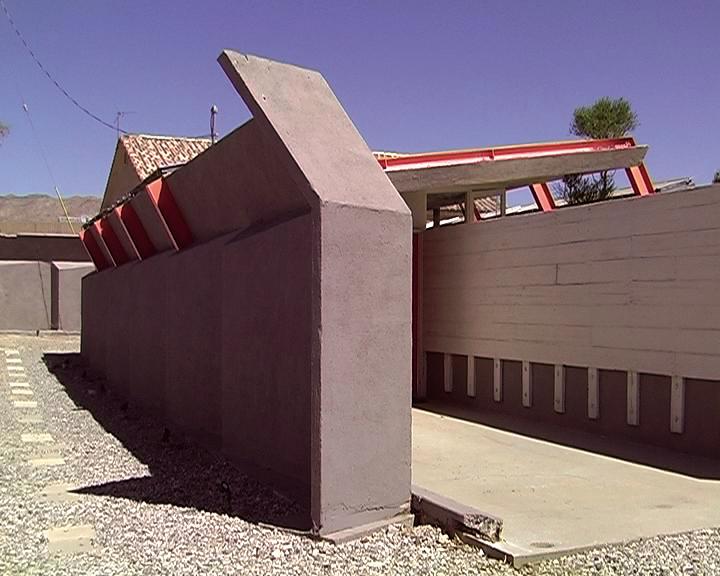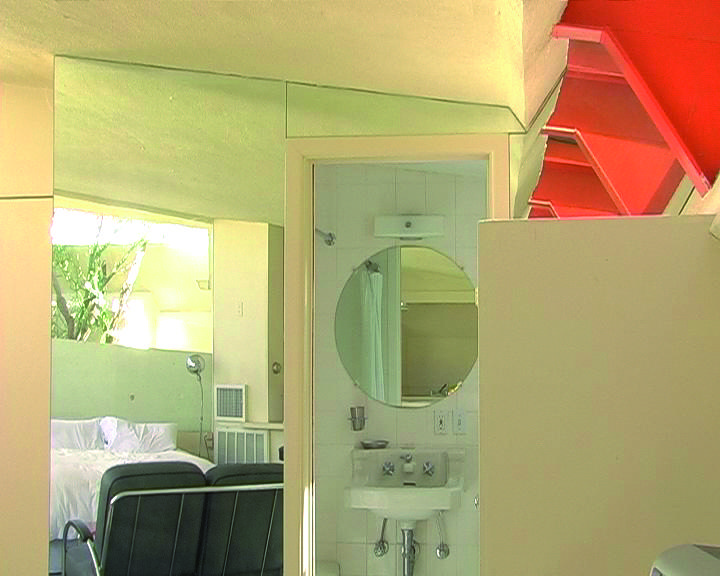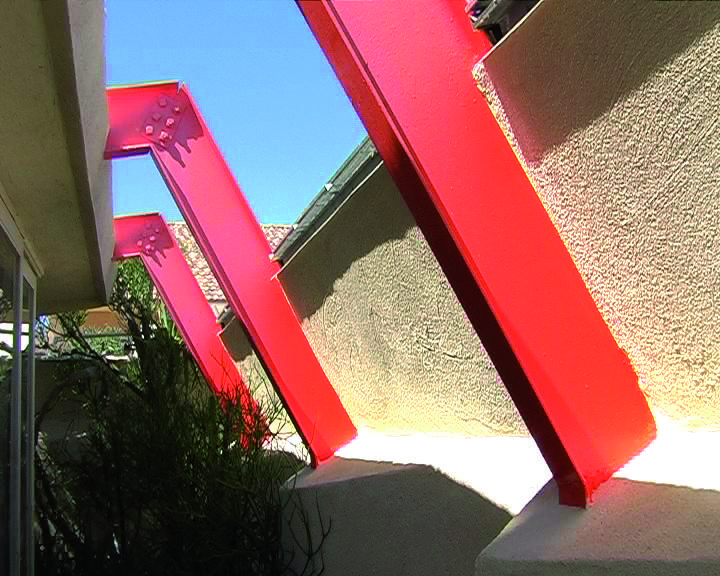John Lautner, The Desert Hot Springs Motel
"Zehn Tage nachdem ich aufhörte, Pornoerzählungen zu schreiben, habe ich William Burroughs kennen gelernt", beginnt die Offstimme in Sasha Pirkers Kurzfilm eine autobiografische Erzählung. Dazu hält die Kamera einige Bilder von Windrädern in der kargen Gegend rund um den Kurort Desert Hot Springs etwa 150 Kilometer östlich von Los Angeles fest. Wie die zur Stimme gehörende Person erschließt sich auch das Gebäude, an dem die Kamera hängen bleibt, erst nach und nach. Es ist das Desert Hot Springs Motel (erbaut 1947) des Architekten John Lautner (1911-1994), dessen ufo-artige Malin Residence (1960; auch Chemosphere genannt) zu den Ikonen der amerikanischen Nachkriegsarchitektur gehört.
Die raue, offensichtlich einem älteren Mann gehörende Stimme erzählt das Leben des Schriftstellers Steve Lowe, der das Wüstenmotel 2000 gekauft, renoviert und den jahrzehntelang unterbrochenen Gästebetrieb wieder aufgenommen hat. Das Video zeigt die Architektur nicht im Stil professioneller Prospektansichten. Als würde ein Gast sich ein Zimmer zeigen lassen, ehe er sich dafür entscheidet, wirft er kurze Blicke auf Details: die Betonwände, die zum Garten hin geöffneten Fenster, die roten, eisernen Dachträger, die sich an die Bergformen der Umgebung anlehnen, die üppige Bepflanzung. Erst allmählich erschließt sich der Sinn der parallel laufenden Ton- und Bildspur. Gebäude und Hausherr nähern sich einander an, als hätten sie aufeinander gewartet.
Das abenteuerliche Leben Lowes verschmilzt mit der fantastischen, die zuversichtliche und verspielt-funktionalistische Grundstimmung des kalifornischen Modernismus atmenden Architektur. So gelingt es Pirker, Lautners Programm einer auf die Bedürfnisse der Bewohner und den Genius Loci abzielenden Entwurfspraxis in Bilder zu übersetzen.
(Matthias Dusini)
John Lautner, The Desert Hot Springs Motel - transcript
About ten days after I quit writing pornography I met William Burroughs. I had been writing a novel a week for the porno industry in NY and I was writing heterosexual sado masochist books. When I realized no one was proofreading these books, I began writing feminist expreimental novels. Some of the titles were Ladies in Leather, The Cowards Nightmare and Punished Women. These were written under noms de plume like Heather Williams and Rex Aimery. At a certain point after having done this for about six months a number of readers complained to the publisher about these books. They had bought them for purposes that were obvious and the books had nothing to do with the illustrations that were depicted inside the novel. So I was fired and the last three books were not payed for.
About ten days after this event I went walking outside my loft in NY up Center street and I saw William Burruoghs coming toward me. We both had green high topped tennis shoes on. As he approached I recognized him and Id never met him personally and didnt even know he was in the United States as he passed I said: Hello Mr. Burroughs. And he stopped. I introduced myself and he acted like he had recognized my name. We discussed this later and it was probably through Maurice Girodias who was living in NY and who had been an early publisher of William Burroughs when he had lived in Paris.
In any case we were meeting at this point fortuitoustly on the street in front of 21, Center Street, the Atomic Machinery building. And this is where Burroughs had lived in the 1960s and thats why he had taken a walk.
He asked me what I was doing and I told him I was unemployed that I had just been fired from writing these porno books. And on the street he asked me if I would collaborate with him on a project and we started working that day.
As it turned out we lived about four blocks from one another in Lower Manhattan. We began work on that day on a project that became the novel Cities of the Red Night. I thought we could have the novel ready in one week and it took five years. We worked every day and generally in the afternoons.
That project brought me out west, because Burroughs that summer was hired to teach in a writing school founded by Allen Ginsburg in Boulder, Colorado. So I began to go out west and worked on the novel writing project the same time I relocated and started spending time up in the mountains.
So my work with William Burroughs began sort of a fortuitous meeting on the street and continued until he passed away in 1997. During that period I had a gallery, a graphic arts business, businesses in New Mexico and in New York. I continued working on various projects with him both literary and visual. As it turns out we found out in 1987 that I had been a fan of William Burroughses mothers writing when I was a child. I grew up in a funeral home in Miami, Florida and I used to arrange flowers. In 1987 the year before my father died he sold the funeral home and I had to remove my library from the premises.
When I was moving the books I discovered a book entitled Homes and Flower Arranging by Laura-Lee Burroughs. And this was a book written in 1942 by William Burroughses mother. I purchased it when I was eight years old and I used to recreate these arrangements as a child. Again in the 1980s my father ended up burying William Burroughses son. So about a decade after I met Burroughs his son passed away having been the recipient of the worlds eighth liver transplant. After Billy Burroughs passed away and my father buried him we continued working on various projects an opera in Germany, an opera after the opera in Germany and an opera after that one. And then Burroughs passed away. After 1997 I moved back to New Mexico and then I decided at the end of the millenium to go to California. It was the last week of the last year of the 20th century and I drove to San Francisco. I stopped for one night in Palm Springs and decided to stay there and purchase some property. So my plans changed very quickly and I ended up moving to Palm Springs and leaving New York and New Mexico. In February 2000, on February 5th, I walked into the John Lautner Motel for the first time. This was the anniversary of William Burroughses birthday and this was three years after he died. When I walked in to the Lautner Motel for the first time it was occupied by tenants and the place had been on the market for about four years. The owner was very very rigorous in making a decision on who would purchase the building. Many people had applied to look at the building and made offers to purchase it and the previous owner had decided against that. When I went in that day, Feburary 5th, for some reason I was the person that she decided should own the building. So thats when I bought the John Lautner Motel.
It had been closed for decades as a Motel and had been occupied as a private rental. There are only four rooms. After everyone moved out I decided to re-open it as a teaching tool for John Lautner and as a special destination for people that were searching and interested in important architecture. So I re-renovated the building and re-opened it for what it originally was a short term over night accomodation. The original client Lucien Hubbard had built it as a retreat getaway for himself and his friends. He was a Hollywood writer producer. He produced the movie Wings in 1927 that won the first academy award 1929/1930 he produced and directed The Mysterious Island based on the Jules Verne novel. After World War II he commissioned John Lautner to build this little four room building and it was ten years after John Lautner had helped Frank Lloyd Wright to build Talesien West. So out in the middle of nowhere in this vast desert outside of Los Angeles this little four room unusual building was built for the Hollywood writer producer and his friends. It was always kept very private and never opened to the public. The three inch self supporting gunite walls and the gunite roof that is suspended on Kaiser steel beams are constructed to deflect the high wind and to also create privacy for the guest. Privacy was an ultimate luxury for the Hollywood crowd. They really wanted to be able to go to a place where no one could track them down and where private life was possible. The day I walked in there for the first time on William Burroughs birthday I thought about Burroughs and what a perfect place this would be for a writer or for an artist to work, to be removed from the world but still be part of it, to be surrounded by nature and have an environment that would be conducive to creative work.
Steve Lowe
A Video by Sasha Pirker, 10:34 min., © 2007
John Lautner, The Desert Hot Springs Motel
2007
Österreich, USA
10 min 34 sek



